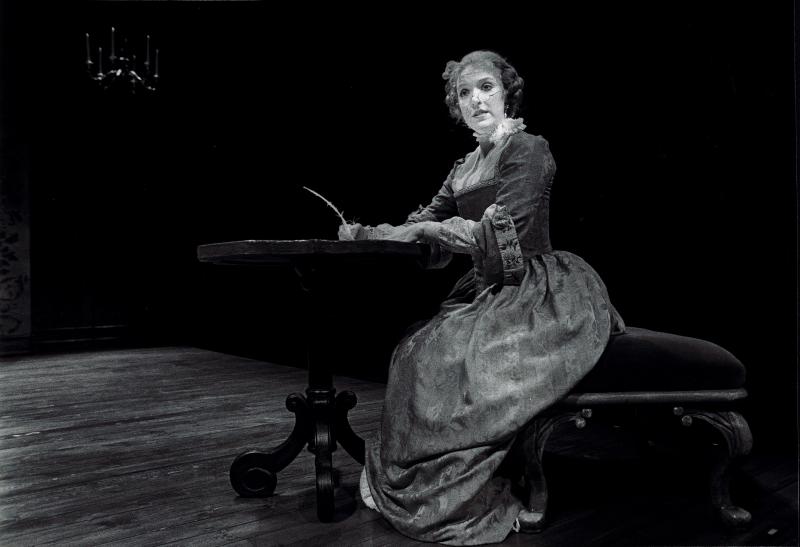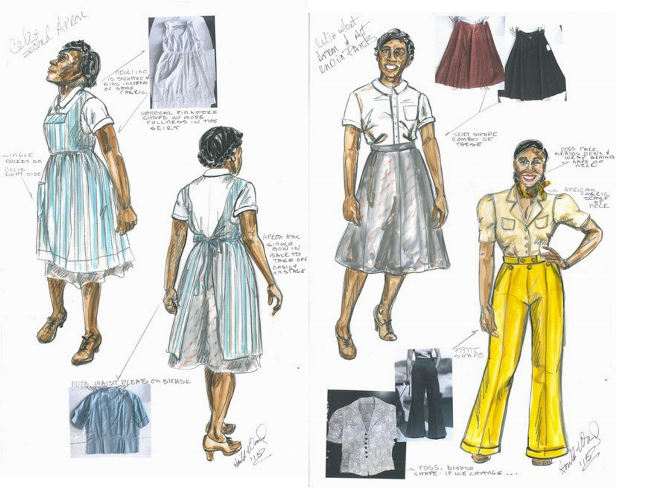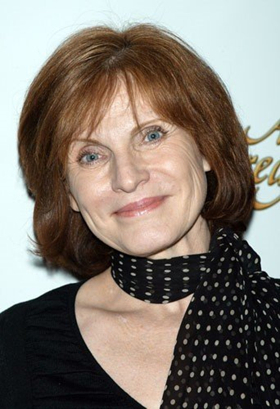Interview: Theatre Life with Ann Hould-Ward
Today's subject Ann Hould-Ward is both a Tony and Drama Desk Award winning costume designer. Her work isn't limited just to the theatre by any means. Besides contributing designs for such legendary Broadway productions as Beauty and the Beast, Into the Woods and Sunday in the Park with George (co-design with her mentor Broadway legend Patricia Zipprodt), her work has also been seen with many dance and opera companies all over the world.
Curently, Ms. Hould-Ward's impressive theatre life work can be seen in our area in the current national tour of The Color Purple, now playing the Kennedy Center's Eisenhower Theater through August 26th. The production is directed by John Doyle with whom Ms. Hould-Ward has worked with on several projects. They include A Catered Affair, Road Show, Passion, and Company.
For you musical theatre fanatics out there, you might also remember her work on the lesser known Harrigan 'N' Hart or Dance of the Vampires.
To give you an idea of Ms. Hould-Ward's versatility, one of her projects could be designing, say for example, a small drawing room comedy. The next one could be an assignment for the Big Apple Circus or a production of Ben-Hur. Her work really runs the gamut of design.
When you watch a production in which actors appear in street clothes you may not necessarily think about who designed them. In reality, every piece of clothing that an actor wears in a professional production anywhere is put together by a costume designer. The breadth of the work is what makes the artistry of Ann-Hould Ward all the more amazing.
With this version of The Color Purple, as you will read, Ms. Hould-Ward's costumes are pretty simple, but there are sections where bursts of color are brought forth. Again, it takes a master of the craft to do this kind of design.
With over 35 years in the business having been trained by the best, and contributing some of the best design work around, Ann Hould-Ward is an example of a true artist whose work continues to endure and delight audiences all over the world.
Who was your biggest influence on becoming a costume designer?
This is hard...my mom who taught me to sew? Also, Patricia Zipprodt, the brilliant costume designer who allowed me to come to NYC and taught me how to be a designer. Additionally, Barbara Matera whose amazing costume shop was my first place of seeing how costumes could be works of art.

What was your first professional design job?
My paper dolls! I grew up with very little money so I made more clothes for them. I was the designer and the client!! Also, the Guthrie Theater in 1982 - The Goldini Trilogy- Summer Vacation Madness. It was my first big professional design job.
Can you please take us through the process of how a costume goes from being just a sketch on a page all the way through to final realization?
A truly good sketch tells the dialogue of the character with the show and enlightens the director and actor as to where the tactile world of the character exists. It is the road map to good work.
Next there are hours of talking with the head of the costume shop who will make the costume. The discussion is about the actual shapes and what they convey - all in relationship to what the actor's body is. From that discussion, you and the shop figure out what fabrics will work; you may look at hundreds of fabrics to find the proper one.
From this, a basic toile of the costume is made after long discussion with the draper who is drafting the pattern. You will fit the basic toile on the actor in muslin fabric and look at the shape and speak with the actor about how it feels to them in regard to the character they are creating and how it responds to the movement they wish to feature. Then you cut into the actual chosen fabrics and refit in the fabrics and try everything again. After that, you are ready for dress rehearsal where changes will be made based on the costumes in relationship to each other, the lighting, etc., etc. Then finally there will be changes in previews as the audience and producers respond. The director et al will then give notes.

Can you please talk about John Doyle's staging of The Color Purple and how it differs from the original Broadway production?
It was a very long time ago in my mind that I saw the original. It was a beautiful production and I remember feeling like I was reading a long novel. John's production is more developed around how we feel as we progress thru life. It relates to the emotion of a situation rather than every small detail - and yet through that you really feel the journey we each make in relation to our lives.

What is your design concept for the costumes in The Color Purple?
John and I looked long and hard at research of real people who lived in the segment of the south where the story transpires. We garnered where we wanted to see each character in their life journey and chose silhouettes according to that rather than making sure they were an exact time period recreation. Each one was based on when we felt Celie remembered them in her life journey - therefore some silhouettes are 1920's and some are 1940's. Yet because they all come from the same "visual poem," they meld together.
When a show like The Color Purple goes on tour, is the costume plot ever modified to make it easier for touring?
In this instance it was not. The costume plot was already highly simple as most actors have only one costume even though we see them through decades. The choice of the costume was about the personality and what it said about them rather than exactly what they would have worn on a given day and place.
What would you say has been your most challenging design for a Broadway production?
Every one is a challenge! Every race day is different. Sometimes it is the heat or the terrain or you feel differently.
All shows are like a race. We need to find what we want to say as a group of people dissect it, understand it, digest it, and create through what we now understand - and present it. Each time the group is different and the world around us is different. Some of the hardest designs may have been right after 9/11 when as a city and nation we were seeking answers and trying to heal.
You designed the costumes for Beauty and the Beast which has played Broadway and all over the world. To what extent did Disney's involvement with the show influence your approach to the costume designs?
Beauty and the Beast, as a late 20th century or early 21st century person knows, is deeply influenced by the early 1990's movie which Disney gave us. I was lucky enough to meet with the animators and have the opportunity to understand their process in developing it, which was a big influence.
We just did a company of the show in Shanghai and we are looking forward to a big future coming up with it.
I have always enjoyed the spectacular care and attention Disney gives to creating a show and the devotion they give to its development.
You've designed for some pretty big names over your career. Michael Crawford and Bernadette Peters are just two examples. Who are a few of your favorite people you have designed costumes for?
I will tell you this way -
One afternoon in 2001, I was in a fitting room fitting prima ballerina Julie Kent in a costume for a new ballet in New York. The next morning at 6 AM, I was fitting elephant blankets on elephants for Ringling Brothers Circus in Florida. From the glory of the divine to the ecstasy of the fantastic - who the heck would think a girl off a dry land farm in Montana would get to do that???
My favorite person is the one with the courage to perform and who needs me and who is collaborative and treats all with charity. I will tell you that the greatest all do that and I hope I do the same.
You've also designed for many famous dance companies. When you design for dance, what do you have to take into account that you don't necessarily need to think about when designing for the stage or film or TV?
Movement!!!
To the ......enth degree!
Not too long ago I worked in Russia for the Mikhailovsky Theatre in St. Petersburg. The extraordinary elegance of a beautiful dancer is a thrill and to help them be able to move like angels is a privilege. I have worked with Lar Lubovitch on many, many dances and I have learned so much about the soul of movement and how it comes from the choreographer to be shared with the dancer. I try to allow myself to investigate the choreographer to the extent that I honor where the creative inspiration they have comes from.
Where can we see your design work during the 18/19 season?
Currently, Carmen Jones at Classic Stage Company (CSC) and Fiddler on the Roof at Folksbeine Theater.
In Fall '18, Arturo Ui at CSC. Others include The Secret Garden (upcoming for Broadway), August Rush (upcoming out of town pre-Broadway tryout), The Cradle Will Rockat CSC, and The Prince of Egypt on the West End.
Special thanks to Kennedy Center's Senior Press Represenative Brendan Padgett for his assistance in coordinating this interview.
Theatre Life logo designed by Kevin Laughon.
Videos

.gif)
